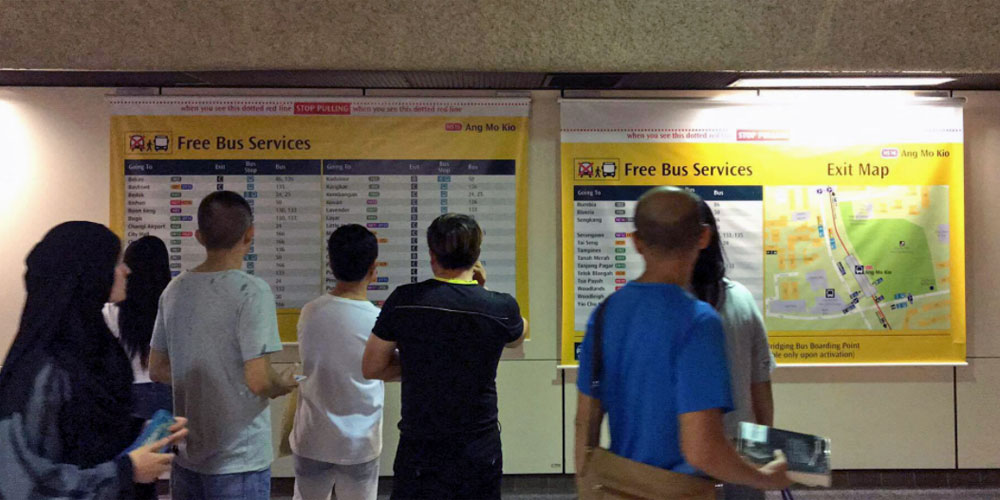Several hundred thousand commuters are likely to have been affected by the 20-hour North-South Line (NSL) MRT breakdown beginning Saturday evening, Oct. 7, 2017, with services resuming only at 1.50pm on Sunday.
[NSL] UPDATE: Train services in both directions btwn #AngMoKio & #Newton have resumed. Free bus & bridging bus svcs are still available.
— SMRT Corporation (@SMRT_Singapore) October 8, 2017
Train services between Ang Mo Kio and Newton stations encompass six stations.
Reason for breakdown
Flooded tunnels due to heavy rain on Saturday crippled operations, and at one point, made trains inaccessible across 13 stations run by SMRT.
Problems started at 5.33pm between Bishan and Braddell before spreading to Ang Mo Kio and Marina South Pier.
Separately, a small fire occurred on the trackside in the tunnel between the Marina Bay and Raffles Place MRT stations at 5.55pm, but died out on its own.
As the weekend runs out, Singaporeans are dreading Monday morning peak hour commute -- if the MRT system acts up again.
Extent of flooding
Images purportedly showing the extent of the flooding in the tunnel have been shared widely on Facebook:
How and why it happened has not been revealed so far.
The tunnel was flooded despite improvement to flood prevention measures recently. Flood barriers at 35 underground MRT stations have been completed across the network.
As part of recovery works, the Singapore Civil Defence Force said it was using portable pumps to remove water in the tunnel and the process was expected to be "a prolonged operation".
Initial official updates provided by SMRT on Sunday slowed to a trickle as it became clear the NSL will not resume by 8am, or even 10am, as originally expected.
However, what is new to Singaporeans this time round is the revelation that MRT tunnels are actually flood-prone.
As have been witnessed in previous episodes, what has occurred before will suddenly start occurring at a greater frequency.
With a vast underground MRT network in existence and more in the works, this does not bode well.
[related_story]
Dealing with it with unusual stoicism
But scenes from the ground suggests Singaporeans are taking to this breakdown with unusual stoicism.

Free alternative transport arrangements have been rolled out for affected stations.
Directions on how to get where, though, can be unwieldy for the elderly, child-bearing and those with infirmities.
A typical 15-minute train ride can extend to between 45 minutes to an hour via bus, inclusive of waiting times.
Alternative transport options
Credible alternative transport options are touted to be available, but they are unlikely to cope with massive demand during MRT breakdowns over the weekend. And when it rains heavily.
North South Line MRT break down pic.twitter.com/IRJUJbZQPh
— Mothership.sg (@MothershipSG) October 7, 2017
To work with easing commuter frustrations, technologically-advanced ride-hailing service Uber announced it temporarily suspended dynamic pricing amid the massive disruption on Saturday.
But such measures are piecemeal and not feasible in the long-run with train services down for prolonged 20-hour stretches.
This is so as the dynamic pricing mechanism is supposed to incentivise drivers to carry out ride-providing services, given foul weather and congestion conditions.
With unpredictable breakdowns the norm and not enough redundancy built into the MRT system to provide alternative channels yet, public transport-reliant Singaporeans will increasingly approach taking the MRT as a game of roulette.
How well they assimilate this new reality into the existing social compact of trading in private modes of transportation for the common good of public transportation, is anybody's guess.
In the meantime, they can continue to meme hard to dispel any existing displeasure with the system:
SMRT predicted the future pic.twitter.com/ShVYWOWqny
— Mothership.sg (@MothershipSG) October 8, 2017
Singaporeans' Maslow's hierarchy of needs basically pic.twitter.com/BGh7NOHvQC
— Mothership.sg (@MothershipSG) October 8, 2017
If you like what you read, follow us on Facebook, Instagram, Twitter and Telegram to get the latest updates.
